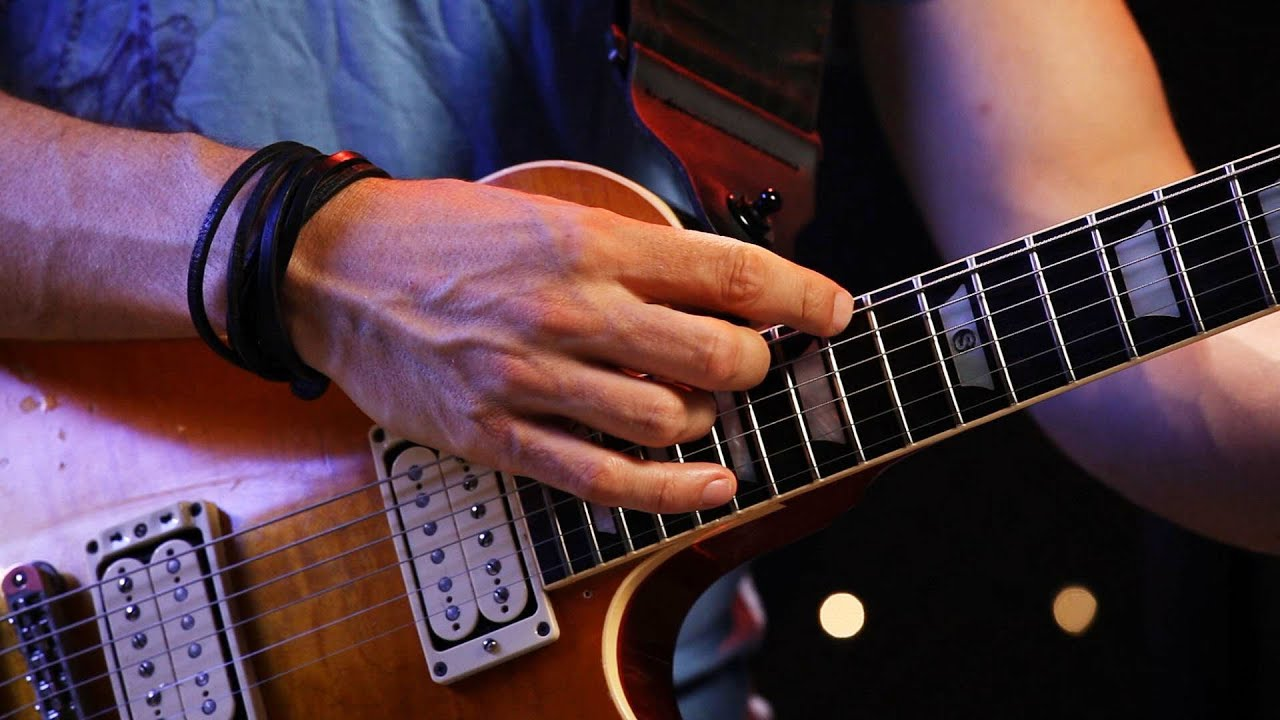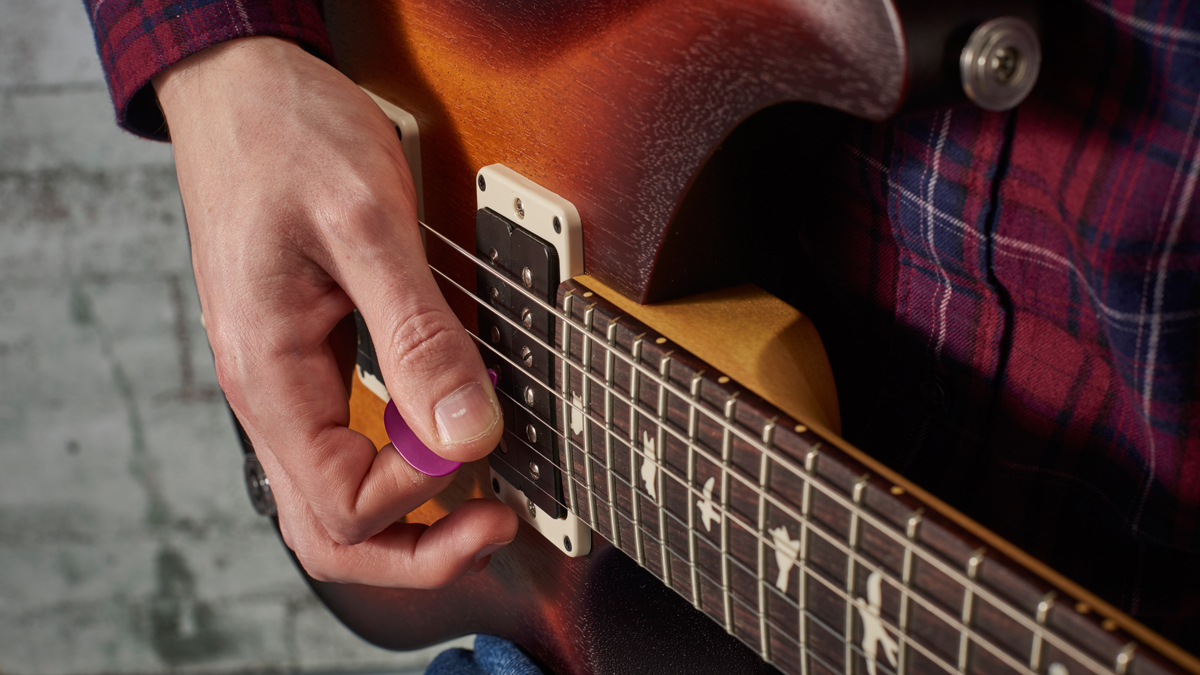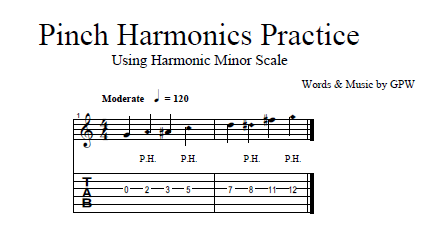Harmonic Pinch – All You Need To Know About This Technique.


Meta Description:
A pinch harmonic, sometimes called a pick harmonic, is used on the guitar to create artificial harmonics. A pinch harmonic is created when you lightly grab a string with your thumb or index finger of the picking hand as it is being played. As a result, one of the harmonics becomes more prominent and cancels out the string’s fundamental frequency.
Let’s take a deep dive into the pinch harmonic technique to fully comprehend it and learn how to apply it to create a range of combinations of sounds to make your performance stand out.
What is Pinch Harmonic?

You must simultaneously pluck a string and touch it at a specific fret to play pinch harmonics and produce a harmonic sound.
Pinch harmonic differs from other techniques as it produces a clear harmonic thin sound that adds texture and depth to a guitar performance. Pinch harmonic also allows for more precise control over the tone and pitch of the harmonics than other guitar techniques, like natural harmonic and artificial harmonics.
How to Play Pinch Harmonics?

This technique is simple to pull off with some practice. So, let me explain how it works.
Although this technique is almost similar to how natural harmonics are played, it is still slightly different as natural harmonics are produced by lightly pressing the string at specific spots around the fretboard. These spots are usually found at the 12th, 7th, and 5th frets. Natural harmonics produce a sound that is a bell-like chiming sound that is an octave or higher above the open string.
However, if you want to play pinch harmonics, place your fretting hand over the string you wish to play before lightly touching the string with your thumb or index finger. Make sure your thumb and index finger are forming a pinching motion.
After that, swiftly remove your thumb or finger from the string after striking it with the hand used for plucking. This will cause the guitar string to vibrate and generate a harmonic note.
Different guitars have different sweet spots for pinch harmonics,, depending on your note. Most of the time, choosing a spot within an inch of the neck pickup will result in the desired squealing sound. However, it is recommended to experiment with different parts of the string to get the best sound with the least effort.
Let me tell you a few tricks and tips that will help you play the pinch harmonics with more precision .
- You should experiment with pick positioning and also use distortion.
- You can also practice in various positions on the guitar neck, which will help to build finger coordination and muscle memory.
- You should get a clean, defined harmonic tone before focusing on speed.
What do Pinched Harmonics Sound Like?
Pinch harmonic is well-known in genres like heavy metal or hard rock. It produces a loud, high-pitched squealing sound to lend a special touch to lead guitar solos and riffs. Pinch harmonics can make lead guitar players more powerful and impact any rock solo when paired with rock vibrato.
This technique can be played acoustic or electric guitar, although the distorted electric guitar technique is the most commonly used. A distorted harmonic provides a powerful and aggressive sound that can be compared to a sneer, scream, screech, or howl.
For example, low vibrations and wailing noises are produced when low-e strings are subjected to pinch harmonics. So, if you play the pinch harmonics technique on top strings at fret 12, you will get a screechy tone. As each point on the fretboard is unique and has a distinctive tone from other areas, try it out and pay attention to how it sounds.
Applications of Pinch Harmonics in Famous Songs

The pinch harmonics have been used in many of your favorite songs, including :
- “Sweet Child O’ Mine” by Guns N’ Roses
- Thunderstruck” by AC/DC
- “The Trooper” by Iron Maiden
- “Tornado of Souls” by Megadeth
- “Blackbird” by The Beatles
- “Bark at the Moon” by Ozzy Osbourne
- “Cemetery Gates” by Pantera
The exciting and adaptable technique of playing pinch harmonics on a guitar can add a unique and dramatic touch to your performance. Guitarists who put time, effort, and patience into it during practice time can easily learn how to use pinch harmonics and incorporate them into their music.
Whether you play heavy metal, blues, or another genre, pinch harmonics on a guitar can be used to create a variety of tones and effects that can improve your performance. Lack of practice can make your guitar playing sound lifeless so practice pinching harmonics on a guitar and let your creativity run wild.
By learning and using pinch harmonics, guitarists can increase the scope of their musical vocabulary and add new techniques to their repertoire. Learning pinch harmonics can enhance both their own and the audience’s enjoyment of their performances.
Zager’s Lesson Library
The best guitar players in the world all have one thing in common: they play by ear. With his widely recognized “Play-By-Ear” guitar approach, Denny Zager has taught millions of people how to play the guitar for over 50 years. This technique allows you to “Play-By-Ear” like an expert by using a portion of your brain that scientists claim we rarely use.
These guitar lessons are a big help for everyone who has just started because it will familiarize you with all these different types of chords and much more in your own guitar-playing journey. Zager’s lesson library includes the following:
- Library with 100’s lessons from a 70 year Master player who’s sold over 20 million records worldwide.
- As seen in Time, Newsweek, The New Yorker, ABC, CBS, NBC, CNN, FOX
- Absolute beginners to professionals
- Learn in hours, not weeks or months.
- Tried and tested by millions of players worldwide.
- Learn when you want, where you want, at your own pace
- Unlimited access 24 hours, seven days a week
- 100% money-back guarantee, lifetime warranty
About Zager
Our renowned method for developing and making guitars combines the best aspects of modern technology and traditional craftsmanship. The fact that Zager’s package deal includes a selection of guitar accessories that contains everything you need to get started is its largest perk for beginners.
The Zager’s accessory pack consists of the following:
- Free Zager pro-ABS digital humidified case $199
- Free lifetime membership to Mr. Zager’s Guitar Lesson Library for $295
- Free years’ worth of Zager custom EZ-Play pillow touch strings for $89
- Free years’ worth of Zager carbon guitar picks for $39
- Free Zager leather padded strap $48
- Free Zager pro stainless capo $39
- Free expedited shipping for $79
Zager guitars are the best and relatively easy to play due to their distinctive string spacing and bracing system. There is no inadvertent buzzing, distortion or rattling because the bracing has so little give in the face. The chords can be created by just lightly pressing the instrument.
FAQ
Can You Pinch Harmonic Without a Pick?
Although playing pinch harmonics without a pick is technically possible, it is usually easier and simpler to perform it with a pick. Using a pick also allows you to produce a harmonic tone that is more distinct and clear.
Is Pinch Harmonic Hard?
The best pinch harmonics are performed with skill and knowledge. Although they can be difficult to master, the pinch harmonic needs and techniques are essential to the sound quality you produce. The use of these methods can help you enjoy music more. With practice, you will become more aware of the many obstacles standing in the way of you from mastering this technique.
What Are the Effects of Pickup Height on Harmonics?
The harmonic richness of the resulting sound can be considerably influenced by the height of the pickups on an electric guitar. Lower pickup height may result in a more subdued, repressed sound, whereas higher pickup height often results in more audible harmonics. A great technique to find the ideal tone is to experiment with various pickup heights.
What Type of Music Uses Pinch Harmonics?
Pinch harmonics are commonly used in rock, metal, and other heavy styles of music since it can add a unique and aggressive sound to guitar riffs and solos.
